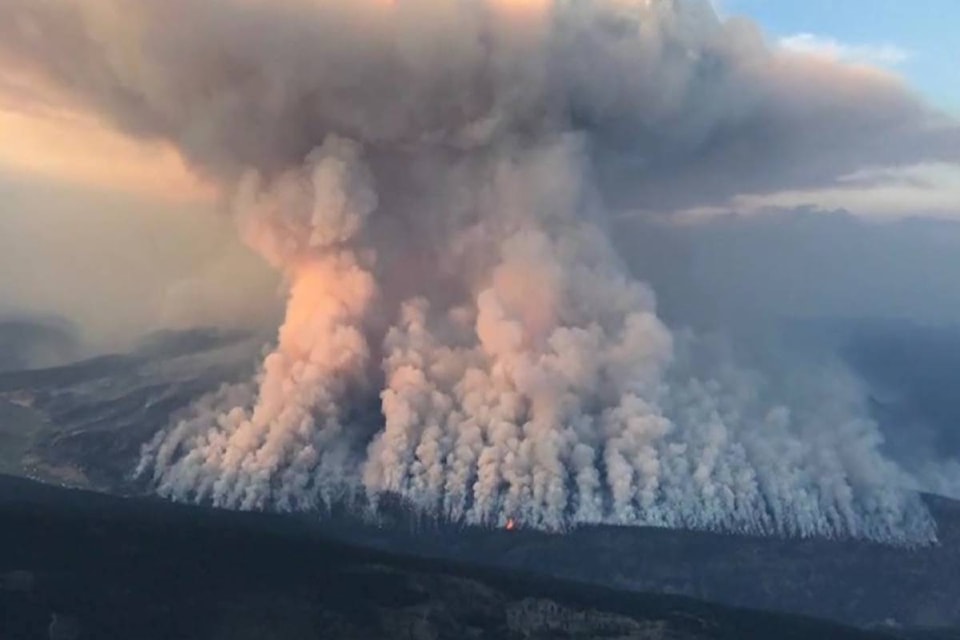This summer several Black Press Media reporters were not only tasked with covering the raging wildfires across the province but many were also living at the front and centre of these blazes.
Forced from their home at the same time as they were providing updates to British Columbians, reporters in Ashcroft, Williams Lake, 100 Mile House and Princeton were at some times the only boots on the ground in communities other media could not get to.
Barbra Roden, the editor and sole reporter of the Ashcroft-Cache Creek Journal was at home when the Elephant Hill wildfire broke out in July.
The Elephant Hill wildfire grew to more than 191,00 hectares, making it a very difficult blaze to cover for reporters as updates were ever-changing.
RELATED: Elephant Hill wildfire still out of control
When the fire originally broke out power was cut to the village of Ashcroft and Cache Creek for 36 hours, there was no landline service, no WiFi, and limited cell service.
Roden was able to find cell service in one particular location, a hill in a subdivision that she just happened to live in.
“My dining room became the Journal office during the week after the fire, because I had to use my cell phone as a hot spot to get my laptop powered up so I could file stories,” she explained.
As wildfires continued to breakout around B.C. misinformation about the Elephant Hill blaze began to spread, and as the only reporter who lived on the front lines of this blaze many began to look to Roden and the Ashcroft-Cache Creek Journal for answers.
RELATED: Ashcroft-area wildfire leaves many homeless, evacuated, and under alert
“Outside media began reporting Ashcroft had been evacuated, and we were never evacuated,” she said. “That caused a lot of panic, and people were turning to me and the Journal to get the facts. This was especially important when Cache creek was evacuated, on July 7, people were scattered everywhere — they needed a source of information.”
RELATED: Ashcroft fire renamed so it would not infer blame on a community
Roden said it was a sad fact to see her little town on the front page of so many news stories, because the village never got any attention before, unless a disaster or tragedy took place.
“I expect Ashcroft, Cache Creek and the surrounding area are going to be recovering from this for a very long time.”
RELATED: Evacuation order issued for village of Clinton, north to Green Lake
To the north of Ashcroft, Max Winkelman, the editor of the 100 Mile Free Press, was also covering the Gustafsen wildfire.
As the fires began to grow and threaten structures, Winkelman’s wife and newborn baby left the area.
However, Winkelman remained on scene, doing his best to give the community and the rest of the province up-to-date information about the blaze.
“I spent a single day shovelling hay, manure, and that type of stuff away from barns on the family ranch,” he said. “Other than that I was really able to zone in making sure that people got all the information they needed.”
RELATED: New evacuation alert for area east of Highway 97, north of 100 Mile House
Winkelman also dealt with misinformation during the wildfire season, he had reports of other blazes sparking up in 100 Mile when in actuality it was all reports about the Gustafson fire.
“People would be seeing the smoke plume and so we would be using a lot time to go check out these fires, which turned out to be the main fire in the South Cariboo.”
The community really came to depend on the 100 Mile Free Press for the right, up-to-date information, said Winkelman.
“It was all the little things, which grocery store had food, regular updates on where the fires were at, not the big headlines, but really the little stuff people wanted that was hard to get.”
RELATED: Where to find food and supplies in the South Cariboo
These local newspapers became integral for other media outlets too, that often weren’t allowed behind the fire line unlike the Black Press reporters who were integrated with the community.
Wildfires by the numbers:
12,164 square kilometres: Area burned, equivalent to more than a third of Vancouver Island. The worst level of destruction since 1958 when 8,560 square kilometres burned.
$562.7 million: Estimated cost of fire suppression. The previous record was $382 million in 2009.
45,000: Approximate number of people displaced at the peak of the fires.
65,000: Total number of people displaced over the entire wildfire season. The previous record was in 2003 when about 45,000 people were forced from their homes.
70 days: Duration of the state of emergency that was declared on July 7. The last time wildfires prompted the province to announce a state of emergency was in 2003, which lasted 43 days.
1,351: Total number of wildfires.
176: Number of fires that started over a single 48-hour period on July 7 and 8.
4,700: Approximate number of personnel deployed at the height of the wildfires, including firefighters and support staff. The tally encompasses the more than 1,200 personnel from outside the province or Canada and the more than 2,000 contractors who helped out.
300: Approximate number of Canadian Armed Forces personnel who assisted.
236: Aircraft deployed, including planes and helicopters.
Zero: People who died in the fires.
Source: BC Wildfire Service
With files from The Canadian Press
